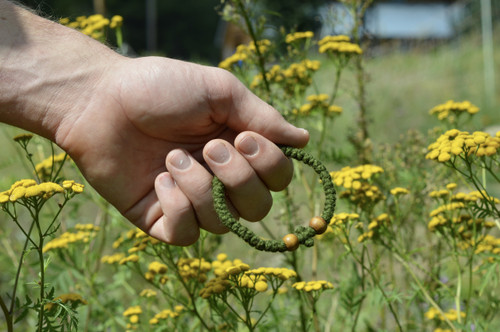This Traditional Lestovka was hand made of rich brown leather in Serbia.
The Lestovka is traditionally constructed of leather, with "steps" made by looping leather around small twigs sections on which paper scrolls with Jesus prayer are wound. It has a total of 109 "steps" – small loops or knots, unevenly grouped: 3/12/38/33/17/3 steps. Traditionally, Lestovki are made from genuine leather, but poorer people make Lestovki from fabric or other materials.
At the bottom of the lestovka hang four lapostki, which are flaps, usually triangular, but such variations as bell or oak-leaf shapes are not uncommon. These represent the four Gospels, and sometimes have icons, crosses, religious symbols or scripture verses printed or stitched on them, the stitching around these leaves symbolising the teaching of the Gospels. Simpler lestovkas will have the lapostki covered with silk brocade or velvet, and this is a traditional way of reusing church fabrics, either of vestments that have become too worn out for clergy to wear, or of altar-coverings and similar fabrics.
Near these lapostki are seven small movable pieces. They are called peredvizki. Some masters make them in the form of 7 crosses or beads. These seven pieces represent the seven Mysteries (Sacraments) of the Church, their location near the leaves of the lapostki indicating their origin in and central relation to the Gospels.
In the Old Believer tradition, seven small moving parts are made invisible. But especially skilled craftsmen make them with an elevator system - they can be extended and then put back in place.
Next, the main loop will have three large steps on either side where it joins the lapostki (in lestovkas that are joined together), and on the Lestovka itself are three more large steps, giving a total of nine, representing the nine months in which Christ was in the womb of the Theotokos (Blessed Virgin Mary), and also for the nine choirs of angels.
After the three large steps on either side is a space, representing the heavens and the earth.
Coming to the main set of counters, one finds twelve small babochki (rungs, steps), signifying the Twelve Apostles. Then are thirty-eight small counters, representing the thirty-six weeks and two days during which the Theotokos carried Christ in her womb. Next, thirty-three small counters for the number of years Christ lived on earth, followed by seventeen small counters for the seventeen Old Testament prophets plus St John the Baptist who prophesied about the coming of Christ.









